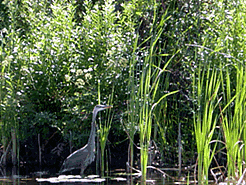What
can you do to help repair & keep the shorelines healthy?
Instead of clearing your shoreline:
- Leave natural vegetation in place and let the shoreline
grow wild: Leaving natural debris such as stumps, fallen
trees or rocks along the shoreline or in the water will
provide food and homes for all types of wildlife
- Plant erosion-prone slopes with native plants and ground
cover.
- Plant drought-resistant native shrubs
- Obtain the proper permits before doing any work
- Pick up and remove garbage
- Locate compost piles far away from the lake
- Keep non-native species out of the watershed: no new
home for pet frogs and turtles
To avoid contaminants & soil erosion
- Use gravel or bricks for driveways or patios to reduce
run-off
- Aerate your lawn to increase its ability to absorb and
hold water
- Replenish disturbed ground-cover areas as soon as possible
and cover exposed soil with tarps during construction
- Plant vegetation at lower elevations than nearby hard
surface to allow runoff to seep into the soil
- Apply manure, bone-meal, peat or other types of mulch
to avoid chemicals
- Use phosphate-free, environmentally-friendly products
such as soaps and detergents. Phosphates cause algal blooms
- Use natural fertilizers and pesticides. Chemical varieties
can kill off animals and aquatic creatures such as frogs
and fish
- Absorb outdoors toxic spills with kitty litter or sawdust
Septic Tank Maintenance
 Have
your septic tank cleaned out every two to five years. Effluent
from failed or poorly maintained septic systems can contaminate
groundwater. Cleaning out your system regularly saves money
and prolongs the life of your septic system (which is expensive
to replace these days, especially due to stringent new government
regulations). Have
your septic tank cleaned out every two to five years. Effluent
from failed or poorly maintained septic systems can contaminate
groundwater. Cleaning out your system regularly saves money
and prolongs the life of your septic system (which is expensive
to replace these days, especially due to stringent new government
regulations).
Indications that your septic system may be in trouble
include:
- Sewage surfacing over the drain-field
- Slow draining toilets and kitchen sinks
- Bad odours from toilets, sinks or nearby the tank itself
Septic Tanks Contamination
Most of the homes on the lake have their septic tanks
and fields within 25 feet of the lake - what would be
considered illegal by today's health standards. If there
is a problem with any one of those tanks or fields, poisonous
chemicals, like formaldehydes and ammonia, can be introduced
to our drinking water - substances that can be deadly.
Additionally, non-degradable products can clog a septic
system which can lead to hundreds to thousands of dollars
to remedy the situation. These systems rely on the effective
bacterial breakdown of all the waste that flows into
them. So beware of what your pour down sinks, toilets
and drains.
The following items can interfere with this
process or even cause it to fail:
- Bleach
- Paints or solvents
- Antifreeze
- Motor oils
- Grease or fats of any kind
- Tampons, sanitary napkins
- Condoms
- Disposable diapers
- Cat litter
- Coffee grounds
- Paper towels
- Metal objects
- Cigarette butts
|
|
 |
 |
 |
 |
| |
If
we are stewards of the
watershed for fish and other
wildlife, we too will be able to
obtain good quality water.

DO'S
- Follow best management practices when living and working
around the lakes and in the watershed
- Properly maintain your septic tanks
- Encourage drinking water providers to follow best management
practices
- Be aware of the different ways to affect shorelines
- Be aware of the "Ribbon of Life"
- Dispose of your garbage properly
- Use non-toxic cleaners and phosphate-free detergents
- Make your own "safe cleaning kit" with baking soda,
pure soap, washing soda, vegetable oil and white vinegar
- Install water reduction attachments
- Leave vegetation undisturbed
DON'T'S
- Don't let the water run continually
- Never flush non-biodegradable products down the toilet.
It can damage your sewage treatment system
- Don't use harsh chemicals anywhere in your home or garden
- Don't let your dog swim in the lake
- Forget to maintain your septic field
- Don't litter or otherwise relieve yourself in your drinking
water
|
|
 |
 |

